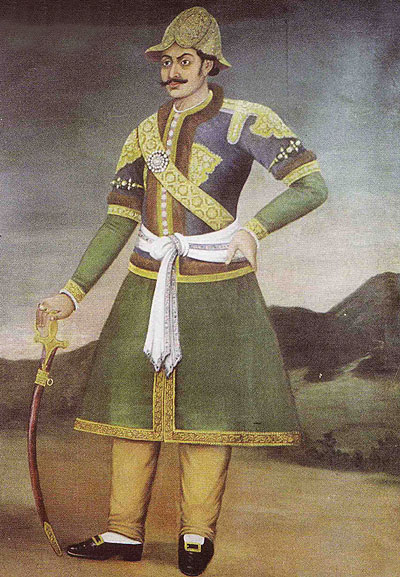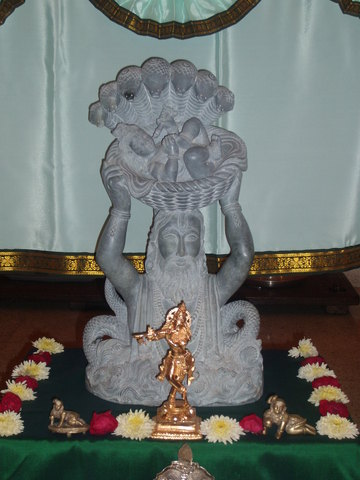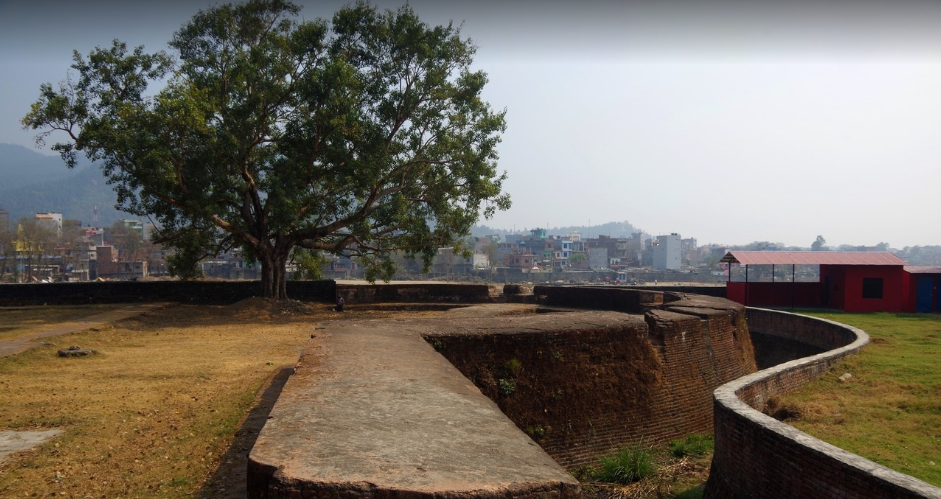|
Rana Ujeshwori Bhagwati Temple
The Rana Ujeshwori Bhagwati temple is located inside the Tansen Durbar square in Palpa district of Nepal. The temple was built by Ujir Singh Thapa as an offering to Goddess Bhagwati on the occasion of victory by Nepal Army over British Raj in Anglo-Nepali War (1872 BS). The temple was destroyed by the earthquake of 1990 BS and was renovated by Pratap Shamsher Jung Bahadur Rana. Bhagwati Jatra A festival called ''Bhagwati Jatra'' (also called ''Sindoor Jatra'') is celebrated every year on the next day of Krishna Janmastami. This festival has been celebrated since 1877 BS. See also *Bhairabsthan Temple *List of Hindu temples in Nepal This is a list of major Hindu temples in Nepal, alphabetically sorted by district. Bajura District * Badimalika Temple (बडिमालिका मन्दिर ) Bara District * Gadhimai Temple * Kankali Temple, Simraungadh * Katg ... References Hindu temples in Lumbini Province Buildings and structures in Palpa District ... [...More Info...] [...Related Items...] OR: [Wikipedia] [Google] [Baidu] |
Nepal
Nepal (; ne, नेपाल ), formerly the Federal Democratic Republic of Nepal ( ne, सङ्घीय लोकतान्त्रिक गणतन्त्र नेपाल ), is a landlocked country in South Asia. It is mainly situated in the Himalayas, but also includes parts of the Indo-Gangetic Plain, bordering the Tibet Autonomous Region of China to the north, and India in the south, east, and west, while it is narrowly separated from Bangladesh by the Siliguri Corridor, and from Bhutan by the Indian state of Sikkim. Nepal has a diverse geography, including fertile plains, subalpine forested hills, and eight of the world's ten tallest mountains, including Mount Everest, the highest point on Earth. Nepal is a multi-ethnic, multi-lingual, multi-religious and multi-cultural state, with Nepali as the official language. Kathmandu is the nation's capital and the largest city. The name "Nepal" is first recorded in texts from the Vedic period of the India ... [...More Info...] [...Related Items...] OR: [Wikipedia] [Google] [Baidu] |
Anglo-Nepali War
The Anglo-Nepalese War (1 November 1814 – 4 March 1816), also known as the Gorkha War, was fought between the Gorkhali army of the Kingdom of Nepal (present-day Nepal) and the British forces of the East India Company (EIC, present-day India). Both sides had ambitious expansion plans for the mountainous north of the Indian subcontinent. The war ended with the signing of the Treaty of Sugauli in 1816 AD, which ceded some Nepalese controlled territory to the EIC. The British war effort was led by the East India Company and supported by a coalition of native states; the Garhwal Kingdom, the Patiala State and the Kingdom of Sikkim against the Kingdom of Gorkha. The Kingdom of Gorkha's war effort was led mostly by the two Thapa families; Thapa dynasty and Family of Amar Singh Thapa. Historical background The Shah era of Nepal began with the Gorkha king Prithvi Narayan Shah invading Kathmandu valley, which consisted of the capital of the Malla confederacy. Until t ... [...More Info...] [...Related Items...] OR: [Wikipedia] [Google] [Baidu] |
Hindu Temples In Lumbini Province
Hindus (; ) are people who religiously adhere to Hinduism.Jeffery D. Long (2007), A Vision for Hinduism, IB Tauris, , pages 35–37 Historically, the term has also been used as a geographical, cultural, and later religious identifier for people living in the Indian subcontinent. The term ''"Hindu"'' traces back to Old Persian which derived these names from the Sanskrit name ''Sindhu'' (सिन्धु ), referring to the river Indus. The Greek cognates of the same terms are "''Indus''" (for the river) and "''India''" (for the land of the river). The term "''Hindu''" also implied a geographic, ethnic or cultural identifier for people living in the Indian subcontinent around or beyond the Sindhu (Indus) River. By the 16th century CE, the term began to refer to residents of the subcontinent who were not Turkic or Muslims. Hindoo is an archaic spelling variant, whose use today is considered derogatory. The historical development of Hindu self-identity within the local In ... [...More Info...] [...Related Items...] OR: [Wikipedia] [Google] [Baidu] |
List Of Hindu Temples In Nepal
This is a list of major Hindu temples in Nepal, alphabetically sorted by district. Bajura District * Badimalika Temple (बडिमालिका मन्दिर ) Bara District * Gadhimai Temple * Kankali Temple, Simraungadh * Katghat Temple, Jitpursimara * Ranivas Temple, Simraungadh * Shree Ram Mandir, Nijgadh Baitadi District * Tripura Sundari Temple Bhaktapur District * Anantalingeshwor Mahadev * Ashapuri Mahadev Temple * Aananta lingeshwor Mahadev * Balakhu Ganesh * Balkumari temple, Bhaktapur, Thimi () * Balkumari Dyochhen () * Barahi Dyochhen () * Bhadrakali Dyochhen () * Bhairav Temple () * Brahmayani Dyochhen () * Changu Narayan () * Chhonga Ganesh * Chhuma Ganesh * Dakshin Barahi Temple, Thimi () * Dattatraya Temple () * Doleshwor Mahadeva Temple () * Indrayani Dyochhen () * Jalbinayak Temple () * Kumari Dyochhen () * Lhasapasa Saraswoti Temple * Mahalaxmi Temple, Bode () * Maheshowri Dyochhen () * Matshya Narayan * Neel Barahi Templ ... [...More Info...] [...Related Items...] OR: [Wikipedia] [Google] [Baidu] |
Bhairabsthan Temple
Bhairabsthan Temple ( ne, भैरवस्थान) is a Hindu temple of Bhairab or Bhairava located about 9 km north west from the city of Tansen, in Palpa district of Nepal at an elevation of about 1470 m msl. History The temple was established by king Mukunda Sena of the Sena dynasty when Palpa used to be the capital. At the time when Mukunda Sena attacked Kathmandu, he returned with the ''murti'' of lord Bhairav from Matsyendra Nath Temple and established it in Palpa as Bhairabsthan Temple. Traditions The temple is visited by the people all over Nepal and mostly by the Hindus of Palpa and nearby districts. Hindu people worship at the temple mainly in ''Mahaastami'' of Dashain. Many pilgrims visit the temple in the month of Mangsir (November -December). The main days for worship at this temple are Tuesdays and Saturdays. During the festivals, animal sacrifices (buffalo, goat, ram and chicken) are performed in the temple. ''Pancha Bali'' is also performed, which invo ... [...More Info...] [...Related Items...] OR: [Wikipedia] [Google] [Baidu] |
Krishna Janmastami
Krishna Janmashtami , also known simply as Krishnashtami, Janmashtami, or Gokulashtami, is an annual Hindu festival that celebrates the birth of Krishna, the eighth avatar of Vishnu. According to the Hindu lunisolar calendar, it is observed on the eighth tithi (Ashtami) of the Krishna Paksha (dark fortnight) of Shraavana Masa (according to the amanta tradition) or Bhadrapada Masa (according to the purnimanta tradition). This overlaps with August or September of the Gregorian calendar. It is an important festival, particularly in the Vaishnavism tradition of Hinduism. Dance-drama enactments of the life of Krishna according to the ''Bhagavata Purana'' (such as Rasa Lila or Krishna Lila), devotional singing through the midnight when Krishna was born, fasting (''upavasa''), a night vigil (Ratri ''Jagaran''), and a festival (Mahotsav) on the following day are a part of the Janmashtami celebrations. It is celebrated particularly in Mathura and Vrindavan, along with major Vaishn ... [...More Info...] [...Related Items...] OR: [Wikipedia] [Google] [Baidu] |
Bhagwati Jatra
Bhagwati may refer to: Surname * Jagdish Bhagwati (born 1934), India-born, naturalized American economist * P. N. Bhagwati (born 1921), 17th Chief Justice of India * Sandeep Bhagwati (born 1963), German-Indian composer of western classical music Given name * Bhagwati Devi Bhagwati Devi (6 November 1936) was a political and social worker and a Member of Parliament elected from the Gaya district constituency in the Indian state of Bihar being a Janta Dal United candidate. Early life Bhagwati Devi was born on 6 No ... (born 1936), politician, social worker, Member of Parliament * Bhagwati Prasad (politician) (died 2013), Indian politician who was elected MLA twice * Bhagwati Singh, politician from Samajwadi Party, Member of the Parliament of India * Bhagwati Charan Verma (1903–1981), author in Hindi * Bhagwati Charan Vohra (1904–1930), Indian revolutionary See also * Kalinchowk Bhagwati Shrine in Dolkha District of Nepal * Bhagwati Temple, Hindu temple in the heart ... [...More Info...] [...Related Items...] OR: [Wikipedia] [Google] [Baidu] |
Pratap Shamsher Jung Bahadur Rana
Pratap Singh (also known as Partap Singh, Pratab Singh, Partab Singh, Pratapsingh, or Partapsingh) may refer to: * Maharana Pratap Singh of Mewar (1540–1597), Rajasthan * Partap Singh Kairon, Chief Minister of Panjab * Partap Singh (1904–1984), Jathedar of Akal Takht * Partap Singh, Sikh priest. *Pratap Singh (cricketer) (born 1993), Indian cricketer *Pratap Singh (Madhya Pradesh politician) *Pratap Singh (politician), member of the Rajasthan Legislative Assembly *Pratap Singh (referee) (born 1971), Indian football referee *Pratap Singh (Sikh prince) (1831–1843), heir apparent of the Sikh Empire *Pratap Singh Bajwa, Indian politician * Pratap Singh Giani, Sikh academician *Pratap Singh II (1724–1753), Maharana of Mewar, India, 1751–1754 *Pratap Singh Nabha (1919–1995), Maharaja of Nabha, India, 1928–1995 * Pratap Singh of Idar (1845–1922), Maharaja of Idar, India, 1902–1911 *Pratap Singh of Jaipur (1764–1803), ruler of Jaipur 1778–1803 * Pratap Singh of ... [...More Info...] [...Related Items...] OR: [Wikipedia] [Google] [Baidu] |
British Raj
The British Raj (; from Hindi ''rāj'': kingdom, realm, state, or empire) was the rule of the British Crown on the Indian subcontinent; * * it is also called Crown rule in India, * * * * or Direct rule in India, * Quote: "Mill, who was himself employed by the British East India company from the age of seventeen until the British government assumed direct rule over India in 1858." * * and lasted from 1858 to 1947. * * The region under British control was commonly called India in contemporaneous usage and included areas directly administered by the United Kingdom, which were collectively called British India, and areas ruled by indigenous rulers, but under British paramountcy, called the princely states. The region was sometimes called the Indian Empire, though not officially. As ''India'', it was a founding member of the League of Nations, a participating nation in the Summer Olympics in 1900, 1920, 1928, 1932, and 1936, and a founding member of the United Nations in San F ... [...More Info...] [...Related Items...] OR: [Wikipedia] [Google] [Baidu] |
Palpa District
Palpa District ( ne, पाल्पा जिल्ला, a part of Lumbini Province, is one of the seventy-seven districts of Nepal, a landlocked country of South Asia. The district, with Tansen as its headquarters, covers an area of and has a population (2011) of 261,180. Palpa District is not far from Pokhara and easily reached by bus. The ancient hill town of Tansen in this district offers a more tranquil atmosphere where laid back lifestyle is infectious. Walk down the cobbled streets in the old bazaar to discover a way of life. Explore the Shreenagar Hills or do a day hike to the Rani Mahal, once a vibrant palace on the banks of the Kali Gandaki River. Palpa was the seat of the Hindu Sen kingdom that ruled over this region from the 16th century for almost 300 years so Headquarter of Palpa is called "Tansen" (Nepali: तानसेन) Geography and climate Demographics At the time of the 2011 Nepal census, Palpa District had a population of 261,180. Of these, 62.08% ... [...More Info...] [...Related Items...] OR: [Wikipedia] [Google] [Baidu] |
Nepal Army
The Nepali Army ( ne, नेपाली सेना, translit=Nēpālī Sēnā), technically the Gorkhali Army ( ne, गोरखाली सेना, translit=Gōrakhālī Sēnā, label=none; see ''Gorkhas''), is the land service branch of the Nepali Armed Forces. During the period of the Nepali unification campaign, it was known as the ''Gorkhali Army'' and later as the ''Royal Nepali Army'' following the establishment of a Hindu monarchy in Nepal. It was officially renamed to the Nepali Army on 28 May 2008, following the abolition of the 240-year-old Shah dynasty shortly after the Nepali Civil War. The Nepali Army has participated in various conflicts throughout its history, going as far back as the Nepali unification campaign launched by Prithvi Narayan Shah of the Gorkha Kingdom. It has engaged in an extensive number of battles within South Asia, and continues to take part in global conflicts as part of United Nations peacekeeping coalitions. The Nepali Army is h ... [...More Info...] [...Related Items...] OR: [Wikipedia] [Google] [Baidu] |
Ujir Singh Thapa
Ujir Singh Thapa or Uzir Singh Thapa ( ne, उजिरसिंह थापा), also known as Wazir Simha Thapa, anglicized as Wuzeer Singh, was Nepalese administrator and military officer. He was the son of Kaji Nain Singh Thapa, a nephew of the Mukhtiyar Bhimsen Thapa and elder brother of Mathabar Singh Thapa. His mother was Rana Kumari Pande, daughter of Mulkaji Ranajit Pande and granddaughter of Kaji Tularam Pande. During his late teenage, he was the military commander at the Palpa-Butwal axis during the Anglo-Nepalese War. He became the Governor (Bada Hakim) and the commander of armed forces deployed in Palpa administrative sector in 1814 AD on substitute of his grandfather Amar Singh Thapa (sanukaji) who died that year. Family and early life Ujir Singh was born on Chaitra ''Shukla Pratipada'' Tithi in the year 1852 of Bikram Samvat (1796 A.D.). He was the son of Kaji Nain Singh Thapa and grandson of Sanu Sardar Amar Singh Thapa. His grandfather died on 7th Kartik 1871 B. ... [...More Info...] [...Related Items...] OR: [Wikipedia] [Google] [Baidu] |

.jpg)


